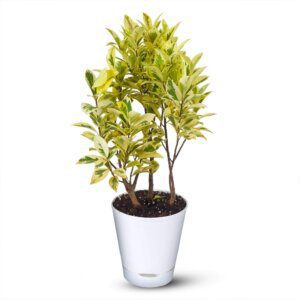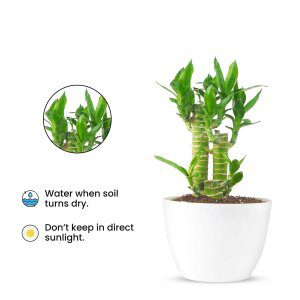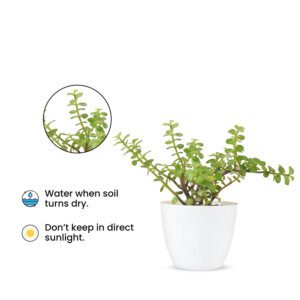

Combo of 4 Air Purifying Indoor Plants (With Self Watering Pots)
- Money Plant Green
- Syngonium White Butterfly Plant
- Song of India Plant (Dracaena Reflexa)
- Peace Lily Plant (Spathiphyllum)
This pack contains 4 air purifying plants potted in self watering fiber pots. Surround your home with these best pollution killer plants for a clean and healthy environment.
About this item
- NASA approved air purifiers that will naturally clean your surroundings.
- Pot contains special soil mix with 6 months slow-release fertilizer.
- All plants are easy to care for and require low maintenance.
- Perfect plants for corporate & personal gifting to your loved ones.
- Plant will be shipped in a good quality cardboard packaging.


Combo of 4 Air Purifying Indoor Plants with Self Watering Pot


Money Plant Plant With Self Watering Pot
Money Plant is the most beloved plant for every home. It has large, glossy, green and yellow heart-shaped leaves with speckles of cream or white markings which can brighten any indoor space.


Syngonium White Plant With Self Watering Pot
Syngonium White Plant, best known as arrowhead vine, is highly popular due to its tolerance of various environments and physical appearance. It’s heart shaped, silver-white, green ornamental leaves make it a suitable plant for home decor.


Song Of India Plant (Dracaena Reflexa Plant) With Self Watering Pot
Song of India is a popular plant that can be grown indoors, and thanks to its easy growth habits, it's a great choice for beginner plant parents. It has alternating dark green and chartreuse stripes on narrow, lanceolate leaves with veins that run parallel along their length.


Peace Lily Plant (Spathiphyllum – Plant) With Self Watering Pot
Peace lily (Spathiphyllum), also known as closet plants, are a popular choice for offices and homes. It has glossy oval leaves with points that emerge from the soil. A well-grown peace lily may bloom twice a year, resulting in several months of flowers.
Special Feature
Though you wouldn’t necessarily associate NASA with indoor plants, the research institute did a study in the late ’80s on plant abilities to purify the air. A healthy home environment is vital to a person’s well-being, and houseplants contribute to it more than you might think. Their main benefit is acting as an air purifier, so it sounds only reasonable that NASA did a Clean Air Study, that found which are the best indoor plants at removing benzene, formaldehyde, trichloroethylene, xylene, and ammonia from our surroundings – chemicals that have been linked to adverse health effects like headaches, dizziness, eye irritation, and others. NASA also recommended having at least one plant per 100 square feet (10 square meters), and although this research is quite old, it is still regarded by many as the most comprehensive and accurate to date.
It won’t surprise you to hear that the majority of people spend the bulk of their time indoors, whether it’s at home or working in an office environment. As such, it’s important to ensure that air quality is of a high standard, something that regular houseplants can help achieve. Back in 1989, NASA conducted a Clean Air Study in association with Associated Landscape Contractors of America and it was found certain indoor plants were very effective in filtering harmful toxins and pollutants from the air. Also, according to SAFAR (System of Air Quality and Weather Forecasting And Research), in 2016, the AQI (Air Quality Index) was 278 (poor) on Diwali and 315 (very poor) the day after. In 2015, it was 279 (poor) on Diwali and 313 (very poor) the next day for Mumbai and the AQI for other major cities was also poor in ranking. This trend suggests that the situation is going to be worse in upcoming years.
A follow-up study in 2019 confirmed that to make a substantial difference to the air quality inside your home, you would need a large number of house plants working together to clean the air – up to 93. But, with houseplants becoming an interior design trend that looks like it’s here to stay, we might as well choose one that will go some of the ways to improve the air we breathe, if not all of it.


| Plants Care Instructions | Don’t use chlorine water (usually tap water) as it kills the root., It should stay moist. If the coco peat is becoming light brown, it should be sprayed with water, Expose the plants to 3-4 hours of daily filtered/ indirect sunlight, Avoid temperature shock by shifting plant between indoors and outdoors on a regular basis for better growth., RO water is chlorine free and recommended, Check the coco peat before watering. |
|---|
























Reviews
There are no reviews yet.